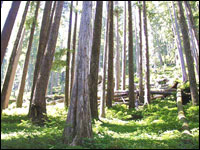Can a “forest economy” be good for the forest? A new movement known as community-based forestry says yes. Also referred to as community forestry, CBF is dramatically different from most forest management practiced in the U.S., and increasing numbers of environmentalists are championing the cause.
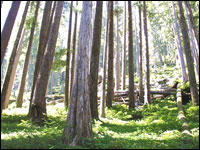
Land of the trees, and
home of the brave.
Photo: NPS.
As the name implies, CBF encourages community members to get involved in forest management. The movement was started by local forest practitioners — loggers, owners of small mills, private landowners, and community planners — in collaboration with other stakeholders, such as environmental organizations and the U.S. Forest Service. Despite their different and sometimes conflicting goals, everyone involved in CBF works toward common goals: restoring and maintaining forest health while respecting local knowledge and bolstering rural economies.
“There is a huge amount of work to be done in the national forests to restore healthy conditions,” says Emily Platt, acting executive director of the Gifford Pinchot Task Force, an environmental organization that supports community-forestry initiatives in the Pacific Northwest. “Community-based forestry holds the greatest potential out there to get the work done.”
Community-based forestry has long been a tool of economic development and ecosystem restoration in other nations. Thomas Brendler, executive director of the National Network of Forest Practitioners, notes that a quarter of the world’s forests are owned by communities. “A community-based forestry forest economy in the U.S. would have a diversity of businesses,” he says. “Everything from trail maintenance to restoration work to low-intensity logging to recreation businesses.”
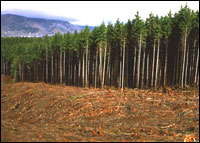
A clearcut in Washington state.
Photo: NPS.
The U.S. has been slow to catch on to CBF, but in the past decade, dramatic changes in land ownership, environmental legislation, and the timber industry have caused rural communities nationwide to seek new approaches to forest-related problems. Many West Coast timber towns, for example, saw their economies bottom out in the 1990s, due to tighter environmental regulations and an industry-wide slump. While those tighter regulations may have slowed the pace of old-growth logging, few new policies — or funds — have come down the pipeline to undo the damage caused by years of heavy logging and the absence of prescribed burns. Rural communities have been spurred to action in order to save their towns and neighboring forests.
“Community forestry takes into account all the different interest groups, from environmentalists to loggers to industry to tribes to the Forest Service,” says Platt. Because it leaves oppositional politics behind, community forestry is often known as the “third way.”
How Green Is Flathead Valley?
In the verdant grizzly bear habitat of northern Montana’s Flathead Valley, a few local loggers forged just such a third way back in the mid-1990s. With the timber industry scaling back, loggers were concerned for their families’ financial well-being. They also saw that the nearby Flathead National Forest, which had not been allowed to burn naturally since 1910, was in ill health. So they sat down in a coffee shop with local environmentalists and began discussing how they could work together.
To help guide the process, which became known as the Flathead Forestry Project, they brought in local economic development expert Carol Daly [Editor’s note: no relation to the author of this article]. “We all participated as individuals, not representatives of organizations,” says Daly. According to her, the loggers in the Flathead Valley didn’t agree with many of the prescriptions of their previous employers, and they wanted a chance to test their own expertise. The community worked closely with Forest Service representatives to devise a thinning and habitat-improvement project on a small stand.
The plan worked. In 1995, Flathead Forestry Project used grant money from the National Forest Foundation and a number of private funders to pay two local logging companies to do the thinning. So far, it’s been a win-win situation. Community members have been monitoring the effect on forest health, and while it is still too early for dramatic changes, Daly says they are already seeing more elk and deer in the stand. Barring natural disaster, the area should continue to improve. Daly expects to see increased species diversity, reduced erosion, and better fire resistance as the stand matures.
Why Can’t We All Just Get Along?
When asked what motivates rural communities to take on the often-arduous work of creating collaboration, Daly says, “People want the land to be healthy. They care about the places they live.” But, she’s quick to add, “It’s not like perfect harmony. There’s still disagreement, and then we have to take a break and go out in the forest together and regain our focus.”
Maia Enzer, a program officer at Sustainable Northwest, says it’s all about process: “Decision making is open, transparent, and inclusive. It’s about local people having a meaningful role in … forest management.” This open and inclusive process is one of the five core principles of community-based forestry.
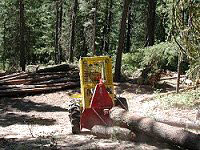
A cut above: selective logging in action.
Photo: Sustainable Northwest.
Stewardship — creating an intimate relationship with the land to ensure that it is cared for by those who live on or near it — is another. “People in rural areas can serve a valuable role as stewards of the forest,” says Brendler of NNFP, for example, through helping with trail maintenance and watershed restoration. “What we are trying to do is live within the ecological limits of the land. Community forestry is not synonymous with big industry.”
But it’s not categorically anti-industry either, notes Enzer. “In the West, community-forestry practitioners acknowledge the skills and innovations to be learned from industry. But they know they can’t rely on industry to take care of them.”
Conventional logging practices have contributed to the boom-and-bust cycle for rural communities, says Platt. Because large lumber companies like High Cascades in Washington state have severely over-logged and clearcut the Gifford Pinchot National Forest, says Platt, environmental litigation and protections have resulted. “The impacts of clear-cutting are extreme,” says Platt, citing damage to streams and to habitat for fish and spotted owls as just a few of the environmental impacts. But now, even High Cascades is beginning to bid on smaller thinning sales, where the Forest Service surveys and manages the stand for endangered species. Smaller-scale timber sales such as those that are a part of community-based forestry don’t result in big controversies, says Platt, and therefore they promise potentially stable jobs for the future — a stability for which rural communities have longed.
Another key difference between community-forestry practitioners and the timber industry is that community forestry “is not about exporting the resources or the profits,” says Enzer. “For years, we took and took from the natural and social capital of forest lands. Now it’s time to reinvest in both.”
Reinvestment, then, is another core principle of community-based forestry. Advocates say that long-term financial and political support on the local, state, and federal levels is key to ensuring the long-term success of restoration. This is one reason Enzer is critical of the Bush administration’s forest plan. “The Healthy Forests initiative has failed to make investments that match its goals,” she says. “You can’t move restoration forward without your pocketbook.”
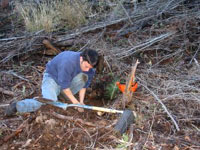
Return of the native plants.
Photo: Sustainable Northwest.
In the Pacific Northwest, that reinvestment takes place on public lands and in the communities that border them. Community-forestry practitioners partner with the Forest Service, environmentalists, and other stakeholders to help restore the forest. Restoration work can include thinning, removing noxious weeds, upgrading culverts, and planting different species in mono-planted areas, among other strategies.
With so many different stakeholders invested in a restoration project, all with different agendas, it is essential that careful monitoring take place. Community-forestry practitioners emphasize what they call “multi-party monitoring” — the movement’s fourth core principle. “Monitoring needs to be funded and implemented in ways that build trust and ensure accountability, so that all stakeholders learn the effects and benefits of the restoration work being done,” Enzer says.
Enzer cites collaboration as the fifth core principle of community forestry. “Collaboration goes beyond decision making,” she says. “We have to figure out how we are going to work together. Stakeholders have to be committed to an ongoing, integrated, civil dialogue.”
Look Who’s Talking
Such dialogue does not come naturally to many rural communities, where political and economic differences have historically worked against productive conversations about forest management. In Northeastern states like Vermont and New Hampshire, most of the forested land is privately owned and non-industrial. According to Shanna Ratner of the Northern Forest Region of the National Community Forestry Center, land sales are frequent, parcel sizes are decreasing, and absentee landowners are plentiful. “Residents in rural areas worry about what is happening to the forest and their communities,” she says.
Ratner’s job is to help rural people build relationships within their community that can address these concerns. “We help people discover new possibilities,” she says. Recently, a town in Vermont asked for the Forestry Center’s assistance in looking into biomass heating, sustainable forest management, and value-added wood processing (in which logs that are harvested sustainably are also processed locally, rather than shipped out of town). Ratner and her colleagues were able to help the citizens come together to work toward their goals.
“We want to return a stewardship role to rural communities,” says Ratner. “I like community forestry because it’s about the community seeing the actual and potential ‘stream’ from the forests — economic, social, and environmental.”
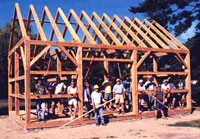
Building community with sustainably harvested lumber.
Photo: Vermont Family Forests.
“The thing that everyone involved in community-based forestry shares is caring about the environment and the health of the forests,” says Barbara Wyckoff-Baird, a senior program associate for community-based forestry at the Aspen Institute. Based in Washington, D.C., with offices in Colorado and Maryland, the nonprofit institute provides seminars and policy programs designed to encourage progressive leadership for complex global issues, including ecological health.
In 1999, the Aspen Institute was selected by the Ford Foundation to be the managing partner of the national Community-Based Forestry Demonstration Program. The Ford Foundation has supported community forestry efforts in the U.S. since 1985, and the Demonstration Program was a way to further invest in on-the-ground projects. Baird and her staff provide technical assistance to 13 pilot programs, traveling from New Mexico to Alabama and beyond to facilitate meetings, business development, and communications for CBF initiatives.
“Our goal is to learn what works and what doesn’t,” said Baird. “These projects weren’t selected to prove something. We want to assist these communities in deriving a sustainable income from sustainable forestry, and we want to distill the lessons learned along the way.”
Baird says success is measured differently depending upon the community and the land itself. While Northwest states may focus on forest restoration, Northeastern states are managing for diverse species and Appalachian states are cultivating non-timber products, such as mushrooms and medicinal herbs. “For some, it’s about jobs created; for others, it’s the number of acres treated for fire prevention,” she says.
Colin Donohue, director of conservation-based development at Rural Action, a nonprofit community organization in Ohio, says community forestry is all about democracy. “For me, community forestry is about finding solutions that work,” says Donohue. “I come from an environmental background. I became disillusioned because a lot of what I saw happening wasn’t strategic. Community forestry is not about rhetoric or posturing.”
With 93 percent of its lands privately owned, Ohio faces similar issues to the Northeast. Because of this, Rural Action focuses on encouraging conservation-based development. “We teach people how to utilize what’s on their land in a sustainable way,” says Donohue. “Wood products can actually help keep forests forests,” rather than allowing them to become industrial sites or shopping malls. “It’s just a matter of doing it right.”
Brendler dubs community-forestry practitioners “the radical middle.” “We’re creating our own center of gravity, not responding to others’ agendas,” he says. “It’s time for the U.S. to make an investment in the social capital of rural areas. People living near the forest have a personal stake in their own — and the forests’ — survival.”
